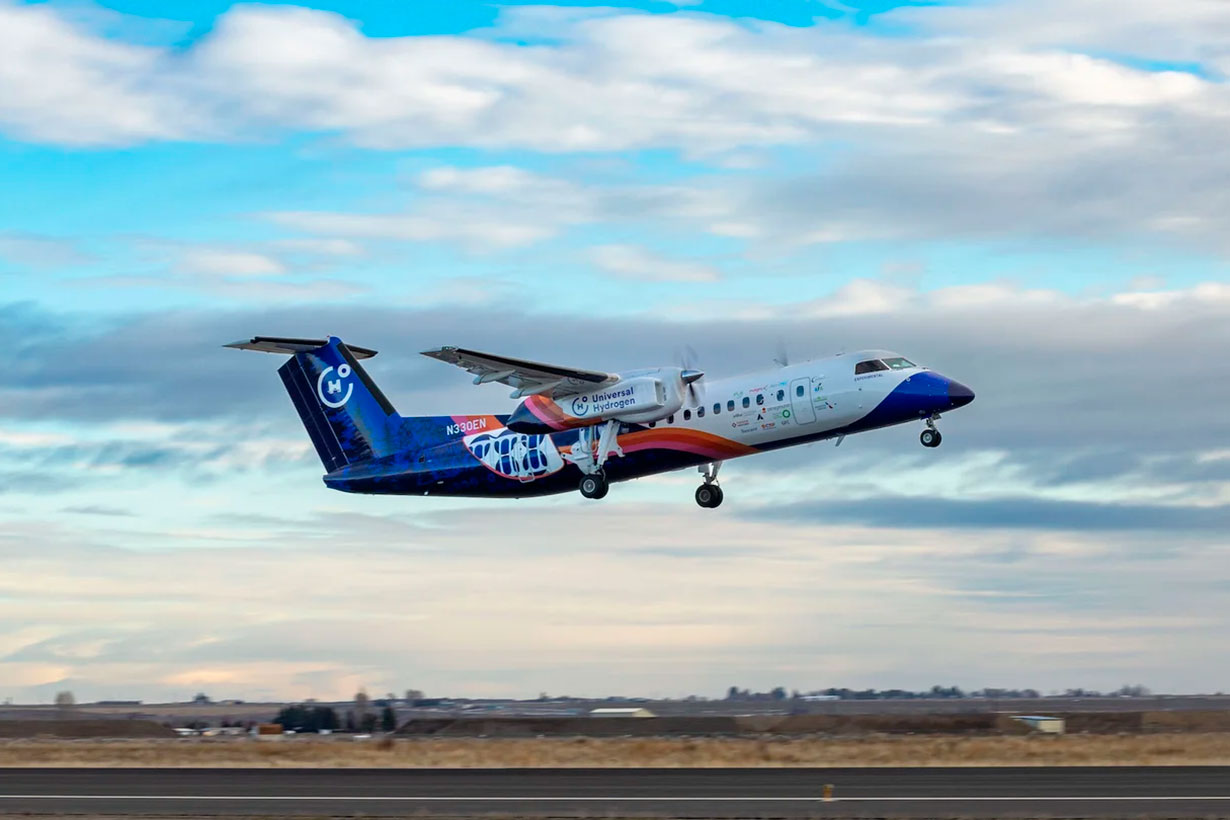CLOSE
About Elements
为了美好的未来,
传播支撑社会的科技
TANAKA是“贵金属”的专家,为世界提供创造“社会价值”的“制造”。
“Elements”是主要提供符合我们的业务及价值观的有关“科技”和“可持续发展”
等方面信息的网络媒体。
在急速发生范式转换的现代,我们将不断传播促进实现更加美好的“社会”和富饶“地球”的未来的启示。

This plane powered by hydrogen has made an electrifying first flight

The engine on the right side of the plane was actually an electric motor running off of hydrogen fuel cells. Top Image Credit: Universal Hydrogen
Last week in Washington state, an airplane that appeared perfectly normal from the outside made a brief flight. On the left side of the plane was a standard engine, burning jet fuel. But on the right side was something radically different: an electric motor that got its power not from batteries, but from hydrogen stored inside the aircraft.
While burning jet fuel creates carbon emissions and particulate matter pollution, in this case the hydrogen system produces water vapor and heat. It’s just one way that aircraft makers are trying to make flying less bad for the planet: companies are working on planes that run off batteries, they are creating synthetic aviation fuel, and in this case, they are leveraging hydrogen fuel cells.
“This is certainly the biggest aircraft to have ever flown on hydrogen fuel cells,” boasts Mark Cousin, the chief technical officer of Universal Hydrogen, the company behind the experimental aircraft.
Here’s how the system works: While the left side of the plane stored its jet fuel in the wing like a typical aircraft, the hydrogen for the electric motor on the right wing was stored in tanks, in a gaseous form, in the back of the plane. “You simply can’t fit hydrogen in the wing of an airplane,” Cousin says. “It was taking up probably about a third of the fuselage length.”
[Related: Watch this sleek electric plane ace its high-speed ground test]
The hydrogen travels up to the right wing, which is where the magic happens. There, in the nacelle hanging off the wing where the motor is, the hydrogen combines with compressed air (the air enters the equation thanks to the two inlets you can see near the motor on the right wing) in stacks of fuel cells. The system uses six stacks of fuel cells, each of which is made up of hundreds of individual fuel cells. Those fuel cell stacks create the electricity that the motor needs to run. “A fuel cell is a passive device—it has no moving parts,” Cousin says. The juice it creates comes in DC form, so it needs to go through inverters to become the AC power the motor requires.
When the plane flew last week, it was a type of hybrid: a regular engine burning jet fuel in the wing on the left side, and the electric motor on the right running off that hydrogen and air. “Once we hit cruise, we throttled back and we flew almost exclusively on the right-hand engine,” the pilot said, according to The Seattle Times. “It was silent.”
Usually holding around 50 people, the aircraft, a modified Dash 8-300, in this case had just three aboard for the test flight, which had a duration of some 15 minutes. It flew at an altitude of about 2,300 feet above the ground. “The aircraft did a couple loops around the airfield,” Cousin says. Then eventually it made a “very, very smooth landing.”
While the aircraft stored its hydrogen in gaseous form in the tanks in the back, the company has plans to switch to a method that stores the hydrogen as a liquid, which occupies less space than the gaseous assembly and doesn’t weigh as much. Those tanks must be kept at very cold temperatures, and the liquid needs to be converted to a gas before it can be used in the fuel cells. While this type of liquid hydrogen setup still takes up more space than regular jet fuel does, it’s a better solution than storing hydrogen in gaseous form, he says. Their plan is to switch the same plane that just flew over to a liquid hydrogen system this year.
In terms of trying to decarbonize the aviation industry—after all, it’s a sizable producer of carbon dioxide emissions—Cousin argues that hydrogen is the best approach. “We think that hydrogen fuel is really the only viable solution for short- and medium-range airplanes,” he says. It’s certainly not the only approach, though. In September of last year, a battery powered plane called Alice also made a first flight in Washington state, and other companies, like Joby Aviation and Beta Technologies, are working on small aircraft that are also battery electric.
Universal Hydrogen isn’t alone in pursuing hydrogen as a means of propelling aircraft. In February of last year, Airbus said that it would use a special, giant A380 aircraft to test out hydrogen technology, and in November, unveiled plans for an electric engine that also runs off hydrogen fuel cells.
Watch a short video about the recent flight, below.
More awesome footage of our first test flight of the world’s largest hydrogen fuel cell powered airliner last week (yes it’s green hydrogen, no it’s not the Hindenburg) pic.twitter.com/8VCkNcMmVx
— Paul Eremenko (@PaulEremenko) March 6, 2023
This article was written by Rob Verger from Popular Science and was legally licensed through the Industry Dive Content Marketplace. Please direct all licensing questions to legal@industrydive.com.









